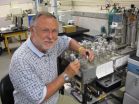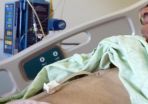(Press-News.org) STANFORD, Calif. — What goes bump in the night? In many U.S. households: people. That's according to new Stanford University School of Medicine research, which found that about 3.6 percent of U.S. adults - or upward of 8.4 million - are prone to sleepwalking. The work also showed an association between nocturnal wanderings and certain psychiatric disorders, such as depression and anxiety.
The study, the researchers noted, "underscores the fact that sleepwalking is much more prevalent in adults than previously appreciated."
Maurice Ohayon, MD, DSc, PhD, professor of psychiatry and behavioral sciences, is the lead author of the paper, which will appear in the May 15 issue of Neurology, the medical journal of the American Academy of Neurology.
Sleepwalking is a disorder "of arousal from non-REM sleep." While wandering around at night can be harmless and is often played for laughs — anyone remember the Simpsons episode where Homer began wandering around and doing silly things in his sleep? — sleepwalking can have serious consequences. Episodes can result in injuries to the wanderer or others and lead to impaired psychosocial functioning.
It is thought that medication use and certain psychological and psychiatric conditions can trigger sleepwalking, but the exact causes are unknown. Also unclear to experts in the field is the prevalence.
"Apart from a study we did 10 years ago in the European general population, where we reported a prevalence of 2 percent of sleepwalking," the researchers wrote in their paper, "there are nearly no data regarding the prevalence of nocturnal wanderings in the adult general population. In the United States, the only prevalence rate was published 30 years ago."
For this study, the first to use a large, representative sample of the U.S. general population to demonstrate the number of sleepwalkers, the researchers also aimed to evaluate the importance of medication use and mental disorders associated with sleepwalking. Ohayon and his colleagues secured a sample of 19,136 individuals from 15 states and then used phone surveys to gather information on participants' mental health, medical history and medication use.
Participants were asked specific questions related to sleepwalking, including frequency of episodes during sleep, duration of the sleep disorder and any inappropriate or potentially dangerous behaviors during sleep. Those who didn't report any episodes in the last year were asked if they had sleepwalked during their childhood. Participants were also queried about whether there was a family history of sleepwalking and whether they had other parasomnia symptoms, such as sleep terrors and violent behaviors during sleep.
The researchers determined that as many as 3.6 percent of the sample reported at least one episode of sleepwalking in the previous year, with 1 percent saying they had two or more episodes in a month. Because of the number of respondents who reported having episodes during childhood or adolescence, lifetime prevalence of sleepwalking was found to be 29.2 percent.
The study also showed that people with depression were 3.5 times more likely to sleepwalk than those without, and people with alcohol abuse/dependence or obsessive-compulsive disorder were also significantly more likely to have sleepwalking episodes. In addition, individuals taking SSRI antidepressants were three times more likely to sleepwalk twice a month or more than those who didn't.
"There is no doubt an association between nocturnal wanderings and certain conditions, but we don't know the direction of the causality," said Ohayon. "Are the medical conditions provoking sleepwalking, or is it vice versa? Or perhaps it's the treatment that is responsible."
Although more research is needed, the work could help raise awareness of this association among primary care physicians. "We're not expecting them to diagnose sleepwalking, but they might detect symptoms that could be indices of sleepwalking," said Ohayon.
Among the researchers' other findings:
The duration of sleepwalking was mostly chronic, with just over 80 percent of those who have sleepwalked reporting they've done so for more than five years.
Sleepwalking was not associated with gender and seemed to decrease with age.
Nearly one-third of individuals with nocturnal wandering had a family history of the disorder.
People using over-the-counter sleeping pills had a higher likelihood of reporting sleepwalking episodes at least two times per month. (Indeed, a sleeping pill was the trigger for Homer Simpson's middle-of-the-night shenanigans.)
D. Le'ger, MD, PhD, from the Universite Paris Descartes in France, was senior author of the study. Researchers from the University of Minnesota Medical School, the Hopital Gui-de-Chauliac in Montpellier, France, and Duke University School of Medicine were also involved.
###
The study was funded by the National Institutes of Health, the Arrillaga Foundation, the Bing Foundation and an educational grant from Neurocrines Biosciences.
Information about Stanford's Department of Psychiatry and Behavioral Sciences, which also supported the work, is available at http://psychiatry.stanford.edu/.
The Stanford University School of Medicine consistently ranks among the nation's top medical schools, integrating research, medical education, patient care and community service. For more news about the school, please visit http://mednews.stanford.edu. The medical school is part of Stanford Medicine, which includes Stanford Hospital & Clinics and Lucile Packard Children's Hospital. For information about all three, please visit http://stanfordmedicine.org/about/news.html.
PRINT MEDIA CONTACT: Michelle Brandt at (650) 723-0272 (mbrandt@stanford.edu)
BROADCAST MEDIA CONTACT: M.A. Malone at (650) 723-6912 (mamalone@stanford.edu)
END
INDIANAPOLIS -- Current colorectal cancer screening guidelines for individuals with first-degree relatives with precancerous colon polyps are based on studies that were not properly designed or were too limited to shape those guidelines, according to a new systemic review of research on the topic. The review authors call for new studies to measure the risk and identify the factors that modify it.
"We found that most studies that are cited for the risk for colorectal cancer when first-degree relatives -- parents, siblings or children -- have a precancerous polyp do not ...
SALT LAKE CITY, May 14, 2012 – If the world's nations ever sign a treaty to limit emissions of climate-warming carbon dioxide gas, there may be a way to help verify compliance: a new method developed by scientists from the University of Utah and Harvard.
Using measurements from only three carbon-dioxide (CO2) monitoring stations in the Salt Lake Valley, the method could reliably detect changes in CO2 emissions of 15 percent or more, the researchers report in the online edition of the Proceedings of the National Academy of Sciences for the week of May 14, 2012.
The method ...
Despite an unprecedented rate of economic growth, Chinese people are less happy overall than they were two decades ago, reveals timely new research from economist Richard Easterlin, one of the founders of the field of "happiness economics" and namesake of the Easterlin Paradox.
In 1990, at the beginning of China's economic transformation, a large majority of Chinese people across age, education, income levels, and regions reported high levels of life satisfaction. Sixty-eight percent of those in the wealthiest income bracket and 65 percent of those in the poorest income ...
Anthropologists working in southern France have determined that a 1.5 metric ton block of engraved limestone constitutes the earliest evidence of wall art. Their research, reported in the most recent edition of the Proceedings of the National Academy of Sciences, shows the piece to be approximately 37,000 years old and offers rich evidence of the role art played in the daily lives of Early Aurignacian humans.
The research team, comprised of more than a dozen scientists from American and European universities and research institutions, has been excavating at the site ...
PROVIDENCE, R.I. [Brown University] — A new study led by Brown University researchers reports that percutaneous endoscopic gastric (PEG) feeding tubes, long assumed to help bedridden dementia patients stave off or overcome pressure ulcers, may instead make the horrible sores more likely to develop or not improve.
The analysis of thousands of nursing home patients with advanced dementia appears in the May 14 edition of the Archives of Internal Medicine.
"This study provides new information about the risks of feeding tube insertion in people with advanced cognitive impairment," ...
What is the connection, if any, between sudden cardiac death and people with HIV/AIDS? And can that knowledge help prolong their lives?
In a comprehensive, 10-year UCSF study, researchers found patients with HIV/AIDS suffered sudden cardiac death at a rate four times higher than the general population.
"As part of my ongoing research in 2010, we were looking at every instance of sudden death in San Francisco," said first author Zian H. Tseng, MD, an electrophysiologist and an associate professor of medicine in the UCSF Division of Cardiology. "I noticed that many of ...
A new study describes a compound that selectively kills cancer cells by restoring the structure and function of one of the most commonly mutated proteins in human cancer, the "tumor suppressor" p53. The research, published by Cell Press in the May 15th issue of the journal Cancer Cell, uses a novel, computer based strategy to identify potential anti-cancer drugs, including one that targets the third most common p53 mutation in human cancer, p53-R175H. The number of new cancer patients harboring this mutation in the United States who would potentially benefit from this ...
Asymptomatic patients who undergo treadmill exercise echocardiography (ExE) after coronary revascularization may be identified as being at high risk but those patients do not appear to have more favorable outcomes with repeated revascularization, according to a report published Online First by Archives of Internal Medicine, a JAMA Network publication. The article is part of the journal's Less is More series.
Cardiac events and recurrent ischemia (a temporary shortage of oxygen caused by impaired blood flow; identified in the study as new or worsening cardiac wall motion ...
According to a small clinical trial reported by investigators from Japan, acupuncture appears to be associated with improvement of dyspnea (labored breathing) on exertion, in patients with chronic obstructive pulmonary disease (COPD), according to a study published Online First by Archives of Internal Medicine, a JAMA Network publication.
The management of dyspnea is an important target in the treatment of COPD, a common respiratory disease characterized by irreversible airflow limitation. COPD is predicted to be the third leading cause of death worldwide by 2020, according ...
Among African Americans with type 1 diabetes mellitus, narrower central retinal arteriolar equivalent (average diameter of the small arteries in the retina) is associated with an increased risk of six-year incidence of any cardiovascular disease and lower extremity arterial disease, according to a report in the May issue of Archives of Ophthalmology, a JAMA Network publication.
"Retinal arteriolar narrowing has long been described as one of the characteristic changes associated with hypertension and cardiovascular disease (CVD)," the authors write as background information ...



